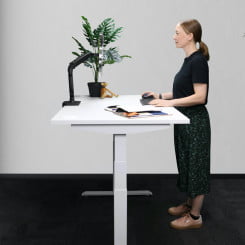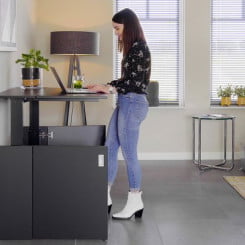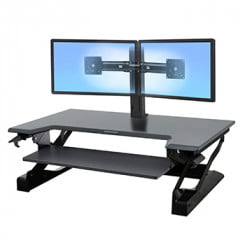Posture People have been advocates of workplace wellbeing for over 10 years. Although awareness of sit-stand workstations has generally risen recently, there is still a lack of guidelines for regular users or the proven benefits for employers. Recently, a consensus statement commissioned by Public Health England and Active Working was released. They gathered experts to provide these guidelines for employers to promote the “avoidance of prolonged periods of sedentary work”. We would highly recommend that standing desk users, or potential users, have a good read through the guidelines (a download is available at the end of this post). Here is our brief synopsis of the guidelines. Please note that the references are provided in the download for further reading.
How long should I spend sitting vs standing?
Focusing on desk-based jobs that are primarily sedentary, guidelines state that you should begin with 2 hours of standing a day, eventually progressing to around 4 hours. There has been a lot of confusion as to whether this should be continuous standing or short bursts throughout the day. We would recommend alternating every 20 minutes. The guidelines also suggest regular breaks and at least 2 hours of light activity during working hours. Prolonged static standing postures should be avoided, so it is worth considering a height adjustable sit/stand workstation that you can adjust easily. Standing at work can take a time to get used to, so remember to rest if you are experiencing muscular fatigue and get your posture checked regularly with a DSE (display screen equipment users) assessment.
-
 HQ Electric Sit Stand Desk£646.80 (incl VAT)
HQ Electric Sit Stand Desk£646.80 (incl VAT) -
 HQ Hideaway Sit Stand Desk£1,004.40 (incl VAT)
HQ Hideaway Sit Stand Desk£1,004.40 (incl VAT) -
 Ergotron WorkFit-Z Mini£372.00 (incl VAT)
Ergotron WorkFit-Z Mini£372.00 (incl VAT) -
 Ergotron WorkFit-TL£546.00 (incl VAT)
Ergotron WorkFit-TL£546.00 (incl VAT)
What are the issues with sedentary office work?
Over the last 5 years, mounting interest in the effects of sedentary lifestyles has led to a variety of published evidence. These studies link time spent working and sedentary lifestyles with increases in cardiovascular disease, diabetes and some cancers. As well as the personal effects, sitting time can also have a knock-on effect for the employer’s profitability, with a rise in sickness, absenteeism and productivity.
What are the benefits of less sedentary lifestyles?
- On average you can burn an extra 0.5-2 kcal per minute vs sitting still
- Shown to reduce muscular-skeletal discomfort such as lower back pain
- May reduce cardio-metabolic diseases and premature mortality alongside better nutrition, reducing smoking, alcohol and stress.
- Reduces fat deposited around vital organs.
Can we design offices to encourage active lifestyles?
More desk-bound work, converging technology and use of public transport has played a big part in modern, sedentary lifestyles. To counteract this, it is important that initial office design takes human factors and ergonomics into consideration. Research from the Furniture Industry Research Association suggests that only 1% of the UK currently have sit-stand desks in comparison 90% of Scandinavian office workers. Whether the solution is to make sit-stand desks the standard, or educating the nation on workplace wellness, it is clear that this needs to be a long-term solution rather than a passing trend.




